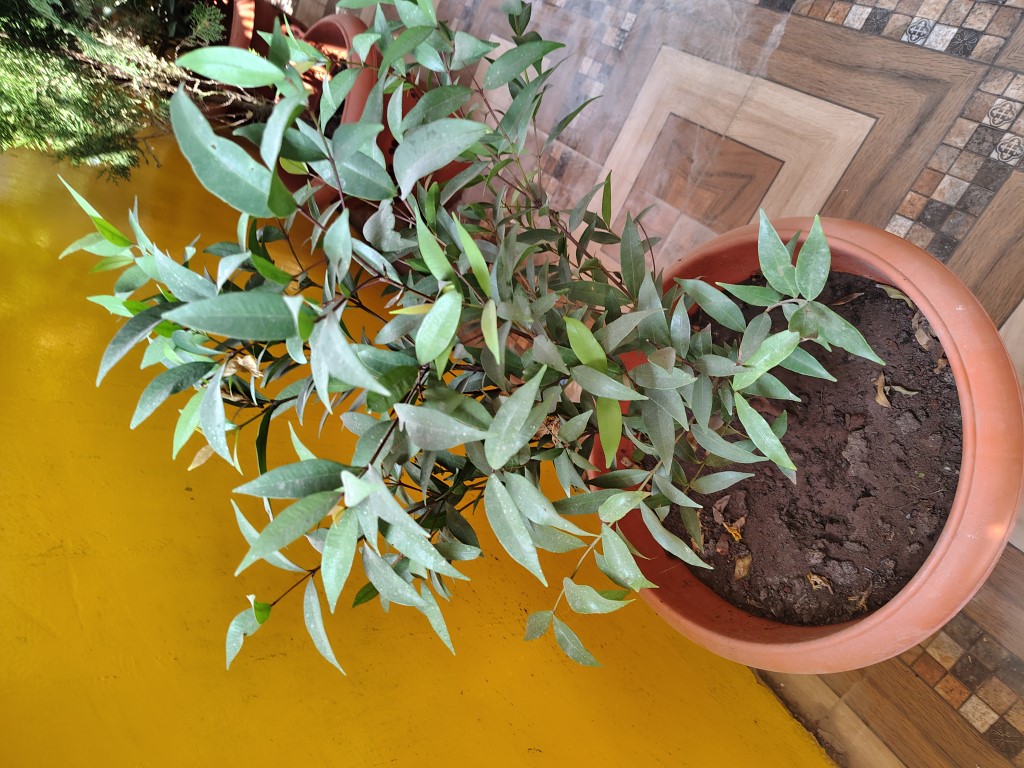Green Campus/Tree Details

नागी पाइन ( Nagi Pine )
नागी वृक्ष (Nageia nagi) हा एक उष्णकटिबंधीय वृक्ष आहे, जो मुख्यतः भारत, जपान, चीन आणि इतर काही दक्षिण-पूर्व आशियाई प्रदेशात आढळतो. या वृक्षाला नागी पाइन असे देखील म्हटले जाते. याचे मुख्य वैशिष्ट्य म्हणजे त्याची लांब, गुळगुळीत पाने आणि एक आकर्षक, पिनसारखा आकार असतो. हा वृक्ष आपल्या सुंदरता आणि सौंदर्यामुळे बागकामात तसेच जंगलातील रक्षणासाठी खूप महत्त्वाचा ठरतो.
1. झाडाची ओळख आणि वैशिष्ट्ये (Identification and Features)
नागी वृक्ष एक सदाहरित आणि पिरॅमिडल आकाराचा वृक्ष आहे, जो साधारणपणे 10 ते 20 मीटर उंच वाढतो. याच्या पानांचा रंग गडद हिरवा असून, ते लांब आणि संकुचित असतात. त्याच्या पानांचा आकार लहान पाइनच्या पानांप्रमाणे असतो आणि त्यात एक आकर्षक पिनसारखी रचना दिसते. या वृक्षाच्या पानांवर गुळगुळीत टेकू असतो, आणि त्याचे पिकलेले पान घातलेले आणि पसरलेले असतात.
नागी वृक्षाची फुलं लहान आणि गव्हाळ रंगाची असतात, आणि इतर सदाहरित वृक्षांपेक्षा त्याच्या फुलांचा आकार जास्त मोठा नसतो. हे फुलं मोठ्या प्रमाणावर झाडावर दिसत असतात, आणि ती पांढरी, पिवळी किंवा लालसर रंगात आढळतात.
2. लागवडीसाठी टिप्स (Planting Tips)
नागी वृक्ष उष्णकटिबंधीय आणि समशीतोष्ण वातावरणात चांगला वाढतो. तो हलका आणि चांगला निचरण करणारा मातीमध्ये चांगला वाढतो. याला नियमित सूर्यप्रकाशाची आवश्यकता असते, आणि हलका अंधार देखील सहन करतो. माती ओलसर ठेवण्यासाठी नियमितपणे पाणी देणे आवश्यक आहे, पण ओलसर मातीमध्ये उभं राहिल्यास त्याचे मुळं सडून जाऊ शकतात.
नागी वृक्ष फारच कमी देखभालीला सहनशील असतो आणि तो कमी पाणी आणि ठंड्या हवामानात देखील चांगला वाढतो.
3. औषधी गुणधर्म (Medicinal Properties)
नागी वृक्षाच्या विविध भागांमध्ये औषधी गुणधर्म असू शकतात. त्याच्या पानांचा वापर औषधांमध्ये केला जातो, ज्यामुळे शरीरातील सूजन कमी करणे, इन्फेक्शनसाठी लवकर बरे होणे आणि रक्तदाब कमी करणे यांसारख्या उपयोगी गुणधर्म आहेत. तथापि, या झाडाच्या औषधी गुणधर्मांवर अधिक संशोधन आवश्यक आहे.
4. सजावट आणि पर्यावरणीय उपयोग (Decorative and Environmental Use)
नागी वृक्षाचे सौंदर्य आणि दृश्यमान आकर्षण हे त्याच्या सजावटीच्या वापरासाठी आदर्श ठरवतात. त्याचे लांब हिरवे पान आणि पिनसारखी रचना बागांमध्ये एक नैतिक व ऐतिहासिक दृष्य निर्माण करतात. याच्या फुलांचा सौम्य आणि शांतिपूर्ण रंग बागकामातील महत्त्वपूर्ण घटक ठरतो.
हा वृक्ष नैतिक रक्षणासाठी, हवामानातील सुधारणा आणि वृक्षारोपणासाठी देखील उपयुक्त आहे. याचे जाड व मजबूत ताण असलेले मुळे पर्यावरणाचे संरक्षण करतात.
5. देखभाल आणि संगोपन (Care and Maintenance)
नागी वृक्षाची देखभाल करण्यासाठी विशेष लक्ष देण्याची आवश्यकता नाही, कारण तो अत्यंत मजबूत आणि कमी देखभालीसाठी सहनशील आहे. त्याला हलका, चांगला निचरण करणारा माती आणि नियमित पाणी आवश्यक आहे. याला काही प्रमाणात पोषणासाठी खत दिले जाऊ शकतात.
The Nagi Tree (Nageia nagi) is an evergreen tropical tree species native to Southeast Asia, including regions like India, Japan, and China. It is also known as the Nagi Pine due to its pine-like appearance. This tree is known for its attractive slender, glossy green leaves that resemble those of pine trees and its ability to thrive in tropical and subtropical climates.
1. Identification and Features
The Nagi Tree is an evergreen tree that typically grows to a height of 10 to 20 meters, with a conical or pyramidal shape. Its leaves are long, narrow, and dark green, resembling the shape of pine needles, giving the tree a distinct pine-like appearance. The leaves are smooth and glossy, and they often grow densely, creating a lush, green canopy.
The flowers of the Nagi Tree are small, typically white or yellow, and appear in clusters. While the flowers are not very large, they are abundant and add to the tree's overall aesthetic appeal. The tree's bark is rough and dark, which contrasts nicely with the vibrant green foliage.
2. Planting Tips
The Nagi Tree thrives in tropical and subtropical climates. It grows best in well-drained, loamy soil, and requires moderate watering. Although it prefers full sunlight, the tree can also tolerate some shade. It is relatively drought-tolerant once established, making it a low-maintenance plant for suitable environments.
The tree is easy to propagate by seed, and young plants should be nurtured in conditions that provide sufficient light and warmth. Over-watering should be avoided, as it can cause root rot.
3. Medicinal Properties
The Nagi Tree has been used in traditional medicine in some regions, with its leaves being utilized for various treatments. It is believed to have anti-inflammatory properties, and extracts from the tree have been used to help with wound healing, reducing swelling, and treating infections. However, more research is needed to fully understand its medicinal benefits.
4. Decorative and Environmental Uses
The Nagi Tree is valued for its ornamental beauty, making it an excellent choice for landscaping in tropical gardens or parks. The tree's tall, conical shape and glossy green foliage create a dramatic visual impact. It is also used in reforestation projects, as it helps stabilize soil and prevent erosion due to its strong root system.
In addition, the Nagi Tree provides environmental benefits by improving air quality and enhancing the aesthetic value of natural landscapes.
5. Care and Maintenance
The Nagi Tree requires minimal maintenance. It thrives in moderately moist, well-drained soil and should be watered regularly, but not excessively. The tree benefits from occasional fertilization to encourage healthy growth. Pruning dead or damaged branches can help maintain its shape and promote further growth.
The Nagi Tree (Nageia nagi) is a beautiful and versatile species with environmental, ornamental, and medicinal uses. Whether planted for landscaping purposes or environmental conservation, this tree adds significant value to any space. Its lush green foliage, slender shape, and low maintenance make it a popular choice for gardeners and environmentalists alike.
